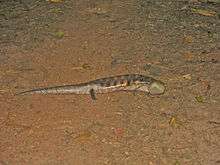Northern blue-tongued skink
| Northern blue-tongued skink | |
|---|---|
 | |
| Scientific classification | |
| Kingdom: | Animalia |
| Phylum: | Chordata |
| Class: | Reptilia |
| Order: | Squamata |
| Family: | Scincidae |
| Genus: | Tiliqua |
| Species: | T. scincoides |
| Subspecies: | T. s. intermedia |
| Trinomial name | |
| Tiliqua scincoides intermedia | |
The northern blue-tongued skink (Tiliqua scincoides intermedia) is the largest and heaviest of the blue-tongued lizards (family Scincidae, genus Tiliqua). They are native to Australia and found almost exclusively in the Northern Region. They generally live around 20 years and are commonly kept as pets.
Appearance
The northern blue-tongued skink (T. s. intermedia) is a subspecies of the eastern blue-tongued lizard (T. s. scincoides). Similar to other blue-tongued lizards, the northern blue-tongued skink has very distinctive patterning. Northerns tend to be a bright orange to soft peachy orange or even a yellowish colour with darker stripes along their sides and backs, with a lighter, creamier colour on their bellies.
They also have bright blue backs often used to warn off or startle predators. Their legs are short and small compared to the length and width of their bodies, and they rarely use their back legs out of laziness. They can grow to about {convert|75|in|cm|abbr=on} total length.
Breeding
The breeding season occurs once yearly. When a male finds a suitable female, he scent-marks and follows her. Mating is aggressive and the male holds the female down by biting her. Damage to the scales and light bleeding are common. This is the only time males are aggressive towards females.
Northern blue-tongued skinks are ovoviviparous. Their gestation period is roughly 100 days with 15 to 20 young born per litter. The offspring look the same as the adults with only slight variations to colouring. They wander off on their own and begin eating small insects and fruit a few days after birth.